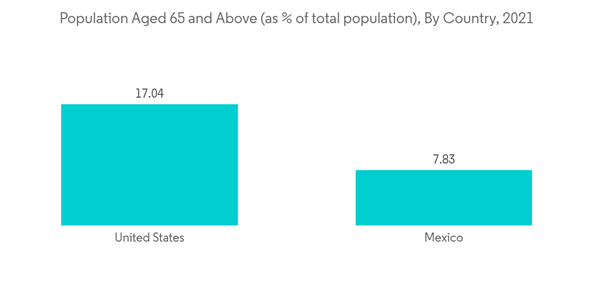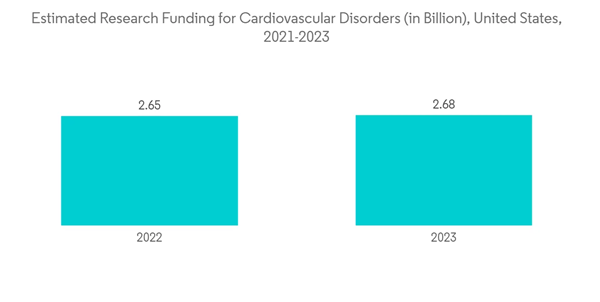The COVID-19 pandemic slowed the growth of the cardiac monitoring market. Due to the high rate of infection and the lack of treatment, many countries had previously shut down and stopped trading with other countries due to travel restrictions, leading to a slowdown for large companies worldwide. Furthermore, according to an article published by BMJ Journals in April 2021, a study was conducted in Europe, which showed that the COVID-19 pandemic significantly impacted the care of patients with cardiac diseases. Therefore, the market was significantly impacted during the early COVID-19 period. However, as the pandemic has subsided, the studied market is expected to have decent growth over the forecast period of study.
In addition, the rising burden of cardiovascular diseases, advancements in technology, and demand for home-based, point-of-care, and remote-monitoring cardiac systems are actively affecting the growth of the studied market. According to the data published by Statistics Canada in July 2022, it is estimated that around 7,330,605 people are aged 65 years or older in Canada, and this accounts for 18.8% of the total population. As the geriatric population is at high risk of cardiovascular diseases, the increasing geriatric population in the region is also boosting the market's growth.
The technological advancements in cardiac monitoring devices, product launches, partnerships, and acquisitions are projected to boost the market growth. For instance, in January 2021, Boston Scientific Corporation acquired Preventice Solutions, a privately held company that provides a full range of mobile cardiac health solutions and services, including ambulatory cardiac monitors like short- and long-term Holter monitors, cardiac event monitors, and mobile cardiac telemetry. Also, in February 2021, Philips acquired Biotelemetry Inc., the United States-based provider of remote cardiac diagnostics and monitoring. The acquisitions are expected to boost the market growth.
Furthermore, in July 2021, Abbott launched Jot Dx in the United States. It is an insertable cardiac monitor (ICM). The Jot Dx ICM provides clinicians and hospitals efficient control of how they manage the flow of information through a unique feature to view all abnormal heart rhythm data or simplify which irregular heart rhythms are recorded with a "key episodes" option. This innovative technology allows for remote detection and improved diagnostic accuracy of cardiac arrhythmia in patients.
Therefore, owing to the factors mentioned above, such as the increasing geriatric population associated with rising cardiovascular diseases, and the product launches, partnerships, and acquisitions, the studied market is anticipated to witness growth over the analysis period. However, the risk of infection due to implantable monitoring devices and unfavorable reimbursement policies is likely to impede the market growth.
North America Cardiac Monitoring Market Trends
The Pacemaker Segment is Poised to Hold a Significant Share in the North American Cardiac Monitoring Market Over the Forecast Period
Pacemakers are medical devices that deliver electrical pulses to the heart to maintain a regular heart rate. Pacemakers are used to treat patients suffering from heart conditions, such as heart failure and arrhythmias. Owing to the increasing prevalence of the geriatric population, cardiovascular diseases, and technological advancements, the pacemaker segment is expected to grow.According to the UN Population Dashboard 2022, the population aged 65 and older as a % of the total population is 17% in the United States in 2022. This surge in the geriatric population is expected to increase the burden of cardiac diseases in North America which is likely to augment the growth of the studied market over the forecast period.
Furthermore, according to the data updated by CDC in October 2022, it is estimated that about 805,000 people in the United States have a heart attack every year, of which 605,000 are estimated to be a first heart attack, and 200,000 heart attacks happen to people who have already had a heart attack. Hence, the segment is projected to show growth over the forecast period.
The advancements in technology, increasing product approvals, partnerships, and collaborations by key players are helping the segment's growth. For instance, in April 2022 Abbott received the United States Food and Drug Administration (FDA) approval of the Aveir single-chamber (VR), the world's one of the first leadless pacemakers for treating patients in the United States with slow heart rhythms.
Thus, owing to the abovementioned factors such the rising geriatric population, rising prevalence of heart disorders, and advancements in technology, increasing product approvals, partnerships, and collaborations by key players, growth in the pacemaker segment of the studied market is expected.
United States is Expected to Hold a Significant Share in the North America Cardiac Monitoring Market Over the Forecast Period
The United States is expected to hold a significant share of the market owing to factors such as the rising incidence of cardiovascular diseases, growing geriatric population, the strong presence of industry players in the country, better healthcare infrastructure, awareness among people and healthcare industry stakeholders about available technologies, and the high concentration of market players in the United States.The technological advancements, product launches, clinical trials, partnerships, and acquisitions by key market players are likely to augment the market growth in the United States. For instance, in December 2021, Boston Scientific initiated a MODULAR ATP trial to assess the mCRM Modular Therapy System, the first modular cardiac rhythm management (CRM) system. The mCRM System consists of two CRM devices: the EMBLEM MRI Subcutaneous Implantable Defibrillator System and the EMPOWER Modular Pacing System. This trial aims to expand treatment options for patients who need an implantable cardioverter defibrillator. These launches are likely to boost the cardiac monitoring market growth.
In addition, in February 2022, Boston Scientific Corporation acquired Baylis Medical Company Inc., a company that provides cutting-edge transseptal access solutions as well as guidewires, sheaths, and dilators used to support catheter-based left-heart surgeries. The acquisition is expected to expand the company's electrophysiology and structural heart portfolio and ultimately boost the market growth in the country.
Therefore, owing to the above-mentioned factors such as the rising incidence of cardiovascular diseases, growing geriatric population, and the strong presence of industry players in the country, the growth of the studied market is anticipated in the United States over the forecast period.
North America Cardiac Monitoring Industry Overview
The North American cardiac monitoring market is fragmented in nature due to the presence of many companies operating regionally. The competitive landscape includes an analysis of a few international as well as local companies which hold the market shares and are well known. Abbott Laboratories, Boston Scientific Corporation, Biotronik, General Electric Company (GE Healthcare), Baxter International Inc (Hill-Rom Holdings Inc.), iRhythm Technologies Inc., Livanova PLC, Medtronic PLC, Schiller AG, Microport Scientific Corporation, Koninklijke Philips N.V. (Biotelemetry), and Canon Medical Systems Corporation among others.Additional Benefits:
- The market estimate (ME) sheet in Excel format
- 3 months of analyst support
This product will be delivered within 2 business days.
Table of Contents
Companies Mentioned (Partial List)
A selection of companies mentioned in this report includes, but is not limited to:
- Abbott Laboratories
- Biotronik
- Koninklijke Philips N.V. (Biotelemetry)
- Boston Scientific Corporation
- General Electric Company (GE Healthcare)
- Baxter International Inc (Hill-Rom Holdings Inc.)
- iRhythm Technologies Inc.
- Livanova PLC
- Medtronic PLC
- Schiller AG
- Canon Medical Systems Corporation
- Microport Scientific Corporation










